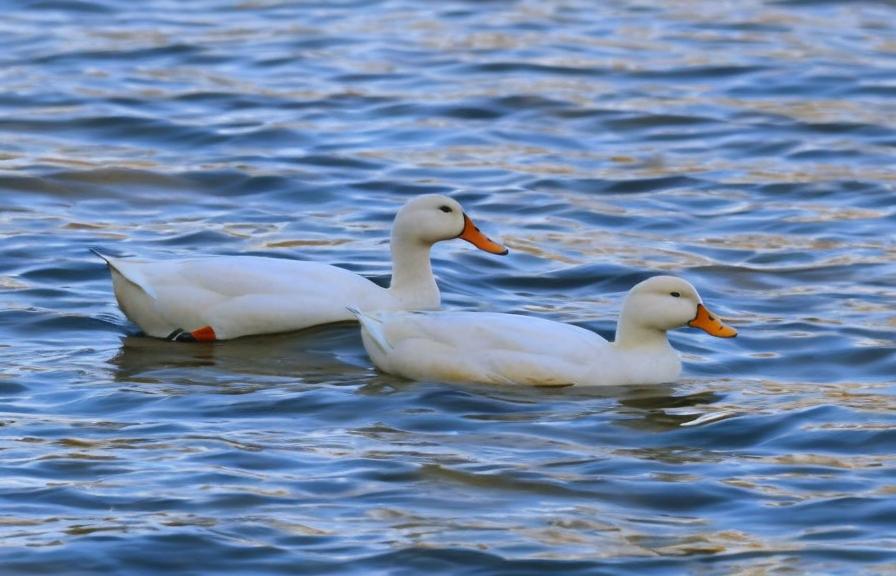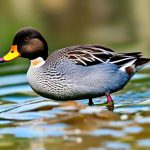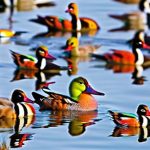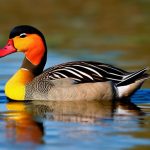Ducks have been a part of Australian agriculture for centuries, providing both meat and eggs for consumption. Australian duck breeds are known for their adaptability to the country’s diverse climate and their ability to thrive in various environments. These breeds have been developed to suit the specific needs of Australian farmers and are valued for their hardiness and productivity. Australian duck breeds are also popular among hobbyists and backyard farmers due to their friendly nature and ease of care. In this article, we will explore the characteristics, history, and uses of Australian duck breeds, as well as the efforts being made to conserve and preserve these unique and valuable birds.
Key Takeaways
- Australian duck breeds are known for their unique characteristics and physical appearance, making them popular among duck enthusiasts.
- Some popular Australian duck breeds include the Australian Spotted, the Australian Call, and the Australian Grey.
- The history and origins of Australian duck breeds can be traced back to the early settlers and their importation of various duck breeds to Australia.
- Australian duck breeds are used for various purposes such as egg production, meat, and as pets or show birds.
- Conservation and preservation efforts for Australian duck breeds are important to maintain genetic diversity and ensure the survival of these unique breeds for future generations.
Characteristics and Physical Appearance of Australian Duck Breeds
Australian duck breeds come in a variety of shapes, sizes, and colors, each with its own unique characteristics. The most common Australian duck breeds include the Khaki Campbell, the Australian Spotted, the Indian Runner, and the Pekin. The Khaki Campbell is a medium-sized duck with a khaki-colored plumage and a slender build. They are known for their high egg production, often laying over 300 eggs per year. The Australian Spotted duck is easily recognizable by its striking black and white spotted plumage. This breed is prized for its meat production and is also a good layer of eggs. The Indian Runner is a tall, upright duck with a distinctive posture and a reputation for being excellent foragers. They come in a variety of colors, including white, fawn, and black. The Pekin duck is a large, heavy breed with a white plumage and a calm disposition. They are primarily raised for meat production and are known for their fast growth rate and high feed conversion efficiency.
In addition to their varied physical appearances, Australian duck breeds also exhibit a range of temperaments and behaviors. Some breeds are known for their docile and friendly nature, making them ideal for backyard farming and as pets. Others are more independent and active, excelling at foraging and adapting to free-range environments. Australian duck breeds are also known for their adaptability to different climates, making them well-suited to the diverse landscapes of Australia. Whether raised for meat, eggs, or as pets, Australian duck breeds offer a wide range of options for farmers and enthusiasts alike.
Popular Australian Duck Breeds
Among the many Australian duck breeds, several have gained popularity for their unique characteristics and suitability for various purposes. The Khaki Campbell is one of the most popular duck breeds in Australia, valued for its high egg production and calm temperament. This breed is often favored by small-scale farmers and backyard enthusiasts for its reliability as a consistent layer of large, white eggs. The Pekin duck is another popular breed in Australia, known for its fast growth rate and excellent meat quality. Pekin ducks are commonly raised on commercial farms for their meat production, as well as by hobbyists looking for a dual-purpose breed that provides both meat and eggs.
The Indian Runner is also a popular choice among Australian duck enthusiasts, prized for its unique upright posture and prolific egg-laying abilities. This breed is often raised by small-scale farmers and hobbyists for its high egg production and entertaining behavior. The Australian Spotted duck, with its striking black and white spotted plumage, has also gained popularity for its meat production and attractive appearance. These popular Australian duck breeds offer a range of options for farmers and hobbyists looking to raise ducks for various purposes, from egg production to meat consumption.
History and Origins of Australian Duck Breeds
The history of Australian duck breeds can be traced back to the early days of European settlement in the country. Ducks were brought to Australia by early colonists as a source of food and income, and over time, various breeds were developed to suit the specific needs of Australian farmers. The Khaki Campbell breed, for example, was developed in England in the late 19th century and later imported to Australia, where it became popular for its high egg production and adaptability to different climates. The Pekin duck has its origins in China but was later introduced to Australia and became widely used for meat production due to its fast growth rate and large size.
The Indian Runner breed has a long history dating back to ancient Southeast Asia, where it was originally used as a foraging duck. This breed was later imported to Australia and has since become popular for its prolific egg-laying abilities and unique upright posture. The Australian Spotted duck is a relatively newer breed that was developed in Australia through selective breeding for meat production and attractive plumage. The history of Australian duck breeds reflects the country’s agricultural development and the ongoing efforts to breed ducks that are well-suited to the diverse landscapes and climates of Australia.
Uses and Purposes of Australian Duck Breeds
Australian duck breeds serve a variety of purposes in agriculture, including meat production, egg laying, pest control, and conservation efforts. The Pekin duck is primarily raised for meat production due to its fast growth rate and excellent meat quality. This breed is commonly used on commercial farms as well as by small-scale farmers looking to raise ducks for meat consumption. The Khaki Campbell is valued for its high egg production, making it a popular choice for farmers seeking reliable layers of large, white eggs. This breed is often raised for egg production on small farms and in backyard settings.
The Indian Runner is known for its prolific egg-laying abilities and is often raised by small-scale farmers and hobbyists looking for a reliable source of eggs. In addition to their roles in meat and egg production, Australian duck breeds are also used for pest control on farms, as they are natural foragers that can help control insect populations. Furthermore, efforts are being made to use Australian duck breeds in conservation programs aimed at preserving rare and endangered duck species. These diverse uses and purposes highlight the versatility of Australian duck breeds in agriculture and conservation efforts.
Care and Maintenance of Australian Duck Breeds

Proper care and maintenance are essential for raising healthy and productive Australian duck breeds. Ducks require access to clean water for drinking and bathing, as well as appropriate shelter to protect them from predators and harsh weather conditions. Adequate space is also important to allow ducks to exercise and exhibit natural behaviors such as foraging and swimming. Feeding ducks a balanced diet that includes grains, greens, and protein sources is crucial for their overall health and productivity.
Regular health checks and vaccinations can help prevent diseases and ensure the well-being of ducks. Additionally, providing nesting boxes or areas where ducks can lay eggs in a safe environment is important for those raising ducks for egg production. Proper care and maintenance practices are essential for ensuring the welfare of Australian duck breeds and maximizing their potential for meat or egg production.
Conservation and Preservation Efforts for Australian Duck Breeds
Conservation efforts are underway to preserve rare and endangered Australian duck breeds, as well as to maintain genetic diversity within existing populations. These efforts include breeding programs aimed at increasing the numbers of rare duck breeds, as well as educational initiatives to raise awareness about the importance of preserving genetic diversity in domesticated animals. Conservation organizations work with farmers, breeders, and enthusiasts to promote sustainable breeding practices that prioritize genetic diversity and the preservation of unique traits within Australian duck breeds.
In addition to breeding programs, conservation efforts also focus on habitat preservation and restoration to support wild populations of ducks in Australia. Wetland conservation projects aim to protect the natural habitats of ducks and other waterfowl species, providing essential breeding grounds and feeding areas. By supporting these conservation efforts, individuals can contribute to the preservation of Australian duck breeds and the maintenance of healthy ecosystems that benefit both domesticated ducks and wild waterfowl populations.
In conclusion, Australian duck breeds play an important role in agriculture, providing meat, eggs, pest control, and conservation benefits. These diverse breeds offer a range of options for farmers and enthusiasts looking to raise ducks for various purposes, from meat production to conservation efforts. By understanding the characteristics, history, uses, care requirements, and conservation efforts related to Australian duck breeds, individuals can contribute to the preservation of these valuable birds and the sustainable management of their populations in Australia’s diverse landscapes.
If you’re interested in learning more about Australian breeds of ducks, be sure to check out the article “The Best Chicken Coop for Your Flock” on PoultryWizard.com. Understanding the different coop options can also provide valuable insights into creating a suitable environment for ducks. (source)
FAQs
What are some common Australian breeds of ducks?
Some common Australian breeds of ducks include the Australian Spotted, the Australian Wood, the Australian Call, and the Australian Grey.
What are the characteristics of Australian breeds of ducks?
Australian breeds of ducks are known for their hardiness, adaptability to various climates, and their ability to forage for food. They also come in a variety of colors and patterns.
What are the uses of Australian breeds of ducks?
Australian breeds of ducks are commonly used for meat and egg production, as well as for ornamental purposes. They are also popular for pest control in agricultural settings.
What are the conservation efforts for Australian breeds of ducks?
Conservation efforts for Australian breeds of ducks include breeding programs to maintain genetic diversity, habitat preservation, and education about the importance of these breeds in the ecosystem.
What are the challenges faced by Australian breeds of ducks?
Challenges faced by Australian breeds of ducks include habitat loss, predation, and competition for resources from introduced species. Conservation efforts aim to address these challenges and ensure the survival of these breeds.
Meet Walter, the feathered-friend fanatic of Florida! Nestled in the sunshine state, Walter struts through life with his feathered companions, clucking his way to happiness. With a coop that’s fancier than a five-star hotel, he’s the Don Juan of the chicken world. When he’s not teaching his hens to do the cha-cha, you’ll find him in a heated debate with his prized rooster, Sir Clucks-a-Lot. Walter’s poultry passion is no yolk; he’s the sunny-side-up guy you never knew you needed in your flock of friends!







